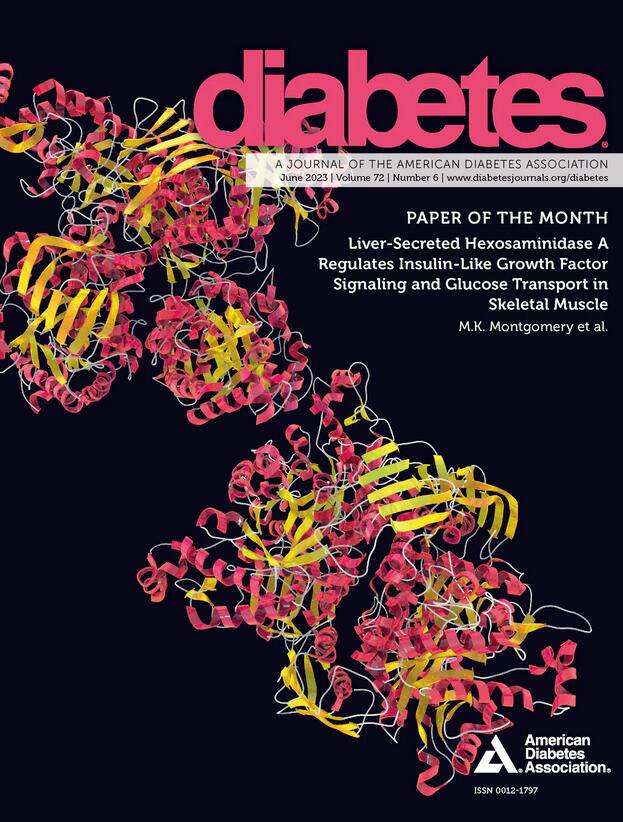The Dorsal Raphe Nucleus and the Integrative Control of Feeding: A Report on Research Supported by Pathway to Stop Diabetes
IF 7.5
1区 医学
Q1 ENDOCRINOLOGY & METABOLISM
引用次数: 0
Abstract
Obesity is a major risk factor for the development of type 2 diabetes (T2D). While the connection between these two disease entities is still incompletely understood, even modest weight loss can greatly reduce the risk of developing T2D and its sequelae. With the recent success of antiobesity pharmacotherapies, which appear to exert their effects largely through the brainstem, there has been a resurgent interest in understanding the neural mechanisms governing food intake and body weight. Over the past decade or so, my laboratory has sought to understand the neural control mechanism underlying energy homeostasis, through the lens of a small region in the brainstem, known as the dorsal raphe nucleus (DRN). The DRN is a molecularly heterogeneous structure in the dorsal midbrain, which we have found contains multiple cell types that are capable of regulating food intake and energy expenditure, and consequently, body weight. Here, I detail progress made by our laboratory and others over the past decade in our understanding of the DRN at the molecular, cellular, and circuit levels, with a particular emphasis on the integrative regulation of feeding. This line of research has established the DRN as an important regulator of energy balance and opens up exciting new lines of inquiry into the neural control mechanism governing food intake and body weight. This article is part of a series of perspectives that report on research funded by the American Diabetes Association Pathway to Stop Diabetes program. ARTICLE HIGHLIGHTS The dorsal raphe nucleus (DRN) is a key regulator of food intake and body weight. The DRN has historically been associated with feeding, as it houses the single largest population of serotonergic neurons in the mammalian brain. Few studies have demonstrated a direct role for DRN serotonergic neurons in regulating feeding; none of these studies have demonstrated effects near those elicited by serotonin, itself. There are many nonserotonergic cell types in the DRN that play an integral role in feeding. These DRN cell types play important roles in both hunger and satiation.中缝背核与摄食的综合控制:一项由通路支持的糖尿病研究报告
肥胖是2型糖尿病(T2D)发展的主要危险因素。虽然这两种疾病之间的联系尚不完全清楚,但即使是适度的减肥也可以大大降低患T2D及其后遗症的风险。随着最近抗肥胖药物治疗的成功,这种药物似乎主要通过脑干发挥作用,人们对理解控制食物摄入和体重的神经机制重新产生了兴趣。在过去十年左右的时间里,我的实验室一直试图通过脑干中一个被称为中缝背核(DRN)的小区域来理解能量稳态的神经控制机制。DRN是中脑背侧的一种分子异质性结构,我们发现它包含多种细胞类型,能够调节食物摄入和能量消耗,从而调节体重。在这里,我详细介绍了我们的实验室和其他人在过去十年中在分子、细胞和电路水平上对DRN的理解所取得的进展,特别强调了摄食的综合调节。这一研究路线确立了DRN作为能量平衡的重要调节器的地位,并为研究控制食物摄入和体重的神经控制机制开辟了令人兴奋的新思路。这篇文章是由美国糖尿病协会资助的一系列研究报告的一部分。中缝背核(DRN)是食物摄入和体重的关键调节因子。DRN历来与进食有关,因为它容纳了哺乳动物大脑中最多的血清素能神经元。很少有研究表明DRN - 5 -羟色胺能神经元在调节摄食中的直接作用;这些研究都没有证明血清素本身所引起的影响。DRN中有许多非血清素能细胞类型在摄食中起着不可或缺的作用。这些DRN细胞类型在饥饿感和饱腹感中都起着重要作用。
本文章由计算机程序翻译,如有差异,请以英文原文为准。
求助全文
约1分钟内获得全文
求助全文
来源期刊

Diabetes
医学-内分泌学与代谢
CiteScore
12.50
自引率
2.60%
发文量
1968
审稿时长
1 months
期刊介绍:
Diabetes is a scientific journal that publishes original research exploring the physiological and pathophysiological aspects of diabetes mellitus. We encourage submissions of manuscripts pertaining to laboratory, animal, or human research, covering a wide range of topics. Our primary focus is on investigative reports investigating various aspects such as the development and progression of diabetes, along with its associated complications. We also welcome studies delving into normal and pathological pancreatic islet function and intermediary metabolism, as well as exploring the mechanisms of drug and hormone action from a pharmacological perspective. Additionally, we encourage submissions that delve into the biochemical and molecular aspects of both normal and abnormal biological processes.
However, it is important to note that we do not publish studies relating to diabetes education or the application of accepted therapeutic and diagnostic approaches to patients with diabetes mellitus. Our aim is to provide a platform for research that contributes to advancing our understanding of the underlying mechanisms and processes of diabetes.
 求助内容:
求助内容: 应助结果提醒方式:
应助结果提醒方式:


